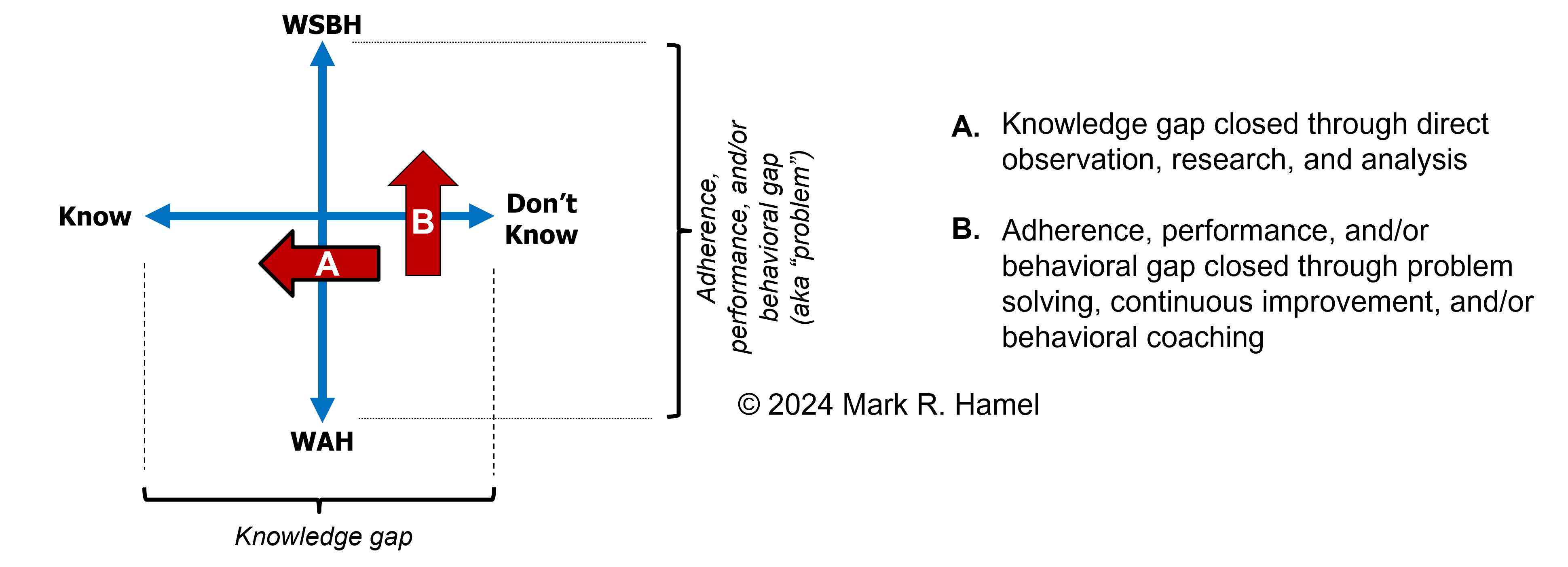OK, we are not talking about the distinctive Japanese horseradish - you know, that green pasty stuff that, when taken in overaggressive quantities, will set your nasal cavity on fire.
Instead, we’re covering one of the simplest, yet most powerful critical thinking devices available to all rational animals…ever. And it’s not just a lean thing.
But first, I need to admit, the device really has nothing to do with wasabi (or wah). The name was the result of a client’s clever rebranding effort during which they, in their lean fever, thought they could make the acronyms WSBH and WAH sound mysteriously Japanese and thus much cooler. I must say, “wasabi wah” does roll off the tongue.
Enough of the weird (but memorable) background.

The First Axis: The Performance, Adherence, and/or Behavioral Gap
What does WSBH and WAH mean? These acronyms stand for “what should be happening” and “what’s actually happening,” respectively. Think of the former as the standard or target condition and the latter as the current condition. Lean practitioners must always have these things at the forefront of their mind. They generate a productive tension and compulsion to characterize the gap and begin to grasp the situation. This is why the term “versus” or “vs.” is at least implicitly inserted between the WSBH and the WAH, thus yielding WSBH vs. WAH.
In lean the WSBH WAH gap is what we call the “problem.” This might be representative of a “caused gap,” to which we apply problem solving and/or behavioral coaching, or a “created gap” (by establishing a WSBH reflective of a better desired future state), to which we apply kaizen and/or behavioral coaching.
Gaps aren’t just the characterization of how much we missed desired performance levels, for example a value stream’s order fill might be 82% versus a 98% target. While this gap type seems to be the one that is top of mind for most folks and hopefully well-displayed on huddle boards, there are two other species. A second gap category is associated with the level of adherence to standards and standard work, for example an associate is not, and perhaps cannot, follow the established standard work in steps, sequence, cycle time, and/or standard WIP. The third WSBH WAH gap is purely behavioral in nature (admittedly adherence/lack of adherence is a behavior, strictly speaking). For example, a leader may demonstrate a behavior during an exchange with a team that can be rightly classified in the unhumble and disrespectful category. This WAH is in marked contrast to the WSBH, leading with humility and respect.
Wait, there’s more!
The Second Axis: The Knowledge Gap
WSBH WAH operates on one axis, but there is another axis that is equally important, and when both are integrated, we get superpowers that enable us to better grasp the situation. This second axis is “Know vs. Don’t Know.”
Before you yawn, think about Taiichi Ohno’s preference for facts over data, or at least think about people’s propensity to assume that they know, when they really do not know (at all). In other words, direct observation is the gold standard. We want gold, even if it requires digging. Research and analysis are supportive activities. Note that frequent direct observations required and specified by leader work, and coaching kata cycles, facilitate much of this “fact” collection, and provides the opportunity to coach folks in the real time application of WSBH WAH thinking.
Ultimately, we need to move from the right side of the matrix, one of ignorance and perhaps bias to the left side of the matrix, where we know or know enough about WSBH and WAH. Only then do we have a foundation firm enough to begin to begin to close the gap.
The Full Wasabi Wah
When we put the two axes together, we get what is reflected in the figure. The schematic does not need to be only conceptual in nature. We can make it practical. If desired, we can draw it on a flip chart or whiteboard and start populating the quadrants (Post-it notes® can be helpful). Often, in short order we can come to some interesting realizations like 1) we aren’t sure what the standard (WSBH) is… or even if a standard exists, or 2) our understanding of the current condition (WAH) is based on some sort of urban legend (perhaps a version of lean Sasquatch).
In the end, the WBSH WAH matrix is a helpful tool. But, most importantly it is about the thinking and the rigor. It’s not unlike the distinction between A3 template and the A3 thinking. When folks start incorporating “wasabi wah” or “wasabi wah?”, into their regular conversation, for example in response to someone complaining about a problem, we know that the thinking is beginning to permeate the organization.
In any event, experiencing wasabi is in the tasting. Go and spread the WSBH WAH!
